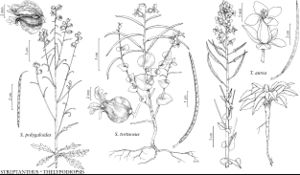Thelypodiopsis
Bull. Torrey Bot. Club 34: 432. 1907.
| Taxon | Illustrator ⠉ | |
|---|---|---|
 | Streptanthus polygaloides Streptanthus tortuosus Thelypodiopsis aurea | Yevonn Wilson-Ramsey Yevonn Wilson-Ramsey Yevonn Wilson-Ramsey |
Annuals, biennials, or, rarely, perennials; not scapose; glabrous or pubescent. Stems (simple or few to several from base), erect [ascending, decumbent], branched basally and/or distally, (glabrous or pubescent). Leaves basal and cauline; petiolate or sessile; basal (soon caducous), rosulate or not, petiolate, blade margins entire or dentate; cauline sessile, blade (base auriculate, sagittate, or amplexicaul), margins entire or dentate. Racemes (corymbose, dense or lax), considerably [slightly] elongated in fruit. Fruiting pedicels erect to ascending or divaricate, slender. Flowers: sepals (equal), usually erect, sometimes ascending or spreading, rarely reflexed, oblong, lateral pair not saccate basally; petals (erect basally), usually white, lavender, or purple, rarely yellow, oblanceolate, oblong, spatulate, or obovate, (margins rarely crisped), claws differentiated or not from blade, (apex rounded); stamens tetradynamous, (exserted); filaments distinct; anthers usually linear, sometimes ovate or oblong (apically coiled); nectar glands confluent, subtending bases of stamens. Fruits stipitate, linear, torulose or smooth, terete; valves each with prominent midvein, usually glabrous, rarely pilose; replum rounded; septum complete; ovules 20–114 per ovary; style distinct, (cylindrical or subclavate to clavate); stigma capitate, usually strongly 2-lobed, rarely entire, (lobes opposite replum). Seeds uniseriate, plump, not winged, oblong; seed-coat (minutely reticulate), not mucilaginous when wetted; cotyledons incumbent or obliquely so. x = 10, 11.
Distribution
w United States, n Mexico
Discussion
Species 10 (9 in the flora).
As recognized by R. C. Rollins (1982b, 1993), Thelypodiopsis was artificially delimited, and no single characteristic or combination of characteristics reliably distinguished it from related genera. Rollins’s circumscription was so broad that it included species of Dryopetalon and Romanschulzia O. E. Schulz.
Of the nine species of Thelypodiopsis that occur in the flora area, three (T. purpusii, T. shinnersii, and T. vaseyi) are quite anomalous and, together with the Mexican T. versicolor (Brandegee) Rollins (Coahuila, San Luis Potosí), eventually may be excluded from the genus. Unlike the other six species, these three have entire or obscurely (versus prominently) 2-lobed stigmas, oblong or ovate anthers 0.5–1 mm (versus linear and 2.5–4 mm), and petal claws obscurely (versus strongly) differentiated from blades. They are here retained in the genus only tentatively and currently are being subjected to detailed molecular and morphological studies, along with Mexican, Central American, and South American taxa.
Selected References
Lower Taxa
Key
| 1 | Anthers ovate or ovate-oblong, 0.5-1 mm; stigmas entire or obscurely 2-lobed; petal claws 0-3 mm | > 2 |
| 1 | Anthers linear, 2.5-4 mm; stigmas 2-lobed; petal claws 3.5-8 mm | > 4 |
| 2 | Cauline leaf blades: proximalmost with pinnatifid to sinuate-dentate margins, distal ones with subamplexicaul or auriculate bases. | Thelypodiopsis purpusii |
| 2 | Cauline leaf blades: proximalmost usually with entire or repand margins, rarely denticulate, distal ones with auriculate bases | > 3 |
| 3 | Proximalmost cauline leaf blades pandurate to broadly obovate; sepals erect; fruits 3.2-7.5 cm; ovules 60-102 per ovary. | Thelypodiopsis shinnersii |
| 3 | Proximalmost cauline leaf blades oblong to lanceolate or oblanceolate; sepals spreading; fruits 1.5-2.5 cm; ovules 20-32 per ovary. | Thelypodiopsis vaseyi |
| 4 | Gynophores slender, 2-6(-9.5) mm | > 5 |
| 4 | Gynophores stout, 0.2-1.5 mm | > 7 |
| 5 | Sepals yellow, spreading to reflexed; petals yellow. | Thelypodiopsis aurea |
| 5 | Sepals purple, erect; petals usually purple or lavender, rarely white | > 6 |
| 6 | Stems glabrous basally; petals 10-14 mm; fruiting pedicels 6-9 mm; styles stout, 0.3-1 mm. | Thelypodiopsis ambigua |
| 6 | Stems pilose basally; petals 14-17 mm; fruiting pedicels 7-20 mm; styles slender, 2-3 mm. | Thelypodiopsis juniperorum |
| 7 | Sepals yellowish; petals yellow, 1-1.7 mm wide, margins crisped. | Thelypodiopsis divaricata |
| 7 | Sepals purplish, lavender, greenish, or white; petals purple, lavender, or white, 3-5 mm wide, margins not crisped | > 8 |
| 8 | Proximal portions of stems and abaxial leaf surfaces often pilose; fruits not tortuous; styles often clavate. | Thelypodiopsis elegans |
| 8 | Proximal portions of stems and abaxial leaf surfaces usually glabrous, rarely sparsely pubescent; fruits tortuous; styles cylindrical. | Thelypodiopsis vermicularis |
"elongated" is not a number."thick" is not a number.